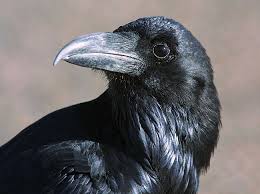Raven Bird
Category: Birds Other

Facts about Raven birds. "Scientific name for Raven bird is Corvus corax". The Raven bird is one among the Corvus type of birds that comes from the several bigger-bodied birds family. The intriguing Raven birds have been coming around people in the Northern Hemisphere for more than a century, following their sleds, wagons, sleighs, and hunting groups in hopes of a fast meal. The Raven bird are among the most elegant of all birds, gaining a status for resolving ever more complex problems invented by ever more inventive scientists. These large, grimy birds flourish among humans and in the back of beyond, extending across the sky on simple, flowing wing beats and filling the unfilled spaces by means of an echoing croak.
Features of Raven bird
A Raven bird is a big-size bird that attains a maximum body length, ranging from 22 inches (55.8 cm) inches to 27 1/4 inches (69 cm), with a wingspan range between 45 3/4 inches (116 cm) and 46 1/2 inches (118 cm). A fully grown Raven bird will have a body mass, ranging from 24.3 pounds (11 kg) to 57.3 pounds (25 kg).
Raven birds appear with a completely black color body, right down to the eyes, legs and beak. They are just big, but gigantic, and they have a thick neck, a Bowie knife of a beak and hairy throat feathers. During the flight, the Raven birds have a long, tail that looks like a wedge. They are slimmer than crows, with long, narrow wings, and thinner, longer fingers at the tip of the wings.
Raven birds inhabit open and forest homes across the northern and western parts of North America. This comprises evergreen and deciduous forests up to tree line, in addition to sea coast, high desert, sagebrush, grasslands and tundra. The Raven bird perform well around people, chiefly countryside settlements, but some cities and towns, too.
The Raven bird is an athletic flier, often performing somersaults and rolls in the air. The Raven bird is capable of flying upside down for over half a mile. Juvenile Raven birds are keen on playing games through the sticks, frequently dropping them, and then diving to grab them in midair.
Raven birds are elegant that makes them hazardous predators. At times, they work in pairs to attack seabird colonies, with one bird disturbing a protecting adult and the other birds waiting to seize an egg or chick once it is exposed. The Raven bird have been observed waiting in the trees while ewes offer birth, then harassing the infant lambs.
Diet of Raven bird
Raven birds are omnivores and they feed on virtually anything they can penetrate. They feed on carrion, small animals that range from the size of baby tortoises and mice to adult nestling Great Blue Herons and Rock Pigeons, grasshoppers, eggs, beetles, scorpions. The Raven bird also feed on several kinds of human food, including unattended picnic foods and garbage.
Breeding of Raven bird
Breeding pairs of Raven birds hold territories and attempt to keep out all other birds all through the year. During the winter season, juvenile Raven birds locating a carcass will call other juvenile birds to the prize. They apparently carry out this to overwhelm the home territory owners by force of amounts to get access to the food.
Behavior of Raven bird
Raven birds are not as friendly as crows, and they can be seen alone or in duos apart from at food resources, such as landfills. The Raven birds are confident, curious, which strut around or rarely bound forward with frivolous, two-footed jumps. During the flight, they are graceful and buoyant, interspersing tall, gliding, and sluggish flaps.
The average lifespan of the Raven bird ranges from 10 years to 15 years.

 Back To Category Birds Other
Back To Category Birds Other